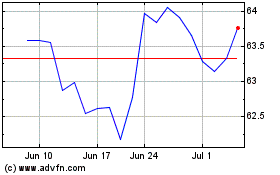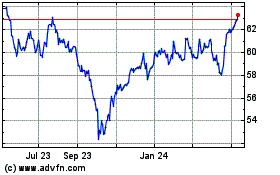Coca-Cola Sales Boosted by Soda Gains, Coffee Push -- 2nd Update
July 23 2019 - 7:21PM
Dow Jones News
By Charlie McGee and Allison Prang
Coca-Cola Co.'s quarterly profit and sales rose, boosted by
higher demand for its namesake soft drinks and the introduction of
coffee, energy drinks and other products.
Organic revenue, which excludes currency swings, acquisitions
and divestitures, increased 6%, with gains in each of Coke's four
major geographies.
Sagging demand for sugary drinks has driven Coke's push to roll
out Coke Zero Sugar, new flavors and diversify its offerings in
recent years.
The product launches have helped revive its core soda business,
where volumes rose 4% in the quarter. Volumes of Coke Zero Sugar, a
reformulated diet soda, rose more than 10% globally, the company
said Tuesday.
Coca-Cola CEO James Quincey said Tuesday on a conference call
that the company has seen steady progress in North America for
sugar-free versions of its drinks. Coke's sales volume in the U.S.
was slightly negative, Mr. Quincey said, as the company raised
prices and focused on smaller-size packaging.
After tempering expectations earlier this year, the company
lifted its forecasts for organic revenue growth and operating
profits for the full year. Shares of Coca-Cola rose 6% on Tuesday
and during the session traded above multidecade highs.
John Murphy, Coke's chief financial officer, said Orange Vanilla
Coca-Cola, rolled out earlier this year as the first new flavor in
a decade, performed strongly in the U.S., while Coca-Cola Plus
Coffee helped sales in Europe.
Mr. Murphy said the company's traditional soda still sells well
in lower per capita markets. He said growth in India was strong,
but in Mexico it has been "a little slower than we would have
liked."
Earlier this month, rival PepsiCo Inc. also posted strong sales
helped by increased advertising and new product launches. The
snacks-and-drinks giant posted a 2.5% increase in North American
beverages revenue with volume rising in its ready-to-drink coffee
and water brands like Lifewtr and Bubly.
Coke is integrating British coffee shop-chain Costa after
closing its $5.1 billion acquisition earlier this year. Mr. Quincey
added Coke has placed 1,200 Costa vending machines so far with
plans for "many more" this year. The machines have only been placed
in current Costa markets, which is primarily the U.K., where most
of the coffee chain's nearly 4,000 cafes are located, and
increasingly in Asia.
Mr. Murphy declined to discuss plans for rolling out the bottled
coffee or vending machines in the U.S. He said the long-term plan
is for Costa to have a global footprint and the company expects to
launch the bottled coffee in six markets before the year's end.
The Costa acquisition gave Coke a recognized coffee brand in the
U.K. But some analysts have questioned the high price Coke paid for
a direct competitor of Starbucks Corp.
Coca-Cola Energy, the company's first energy drink product
bearing its namesake, is now available in more than a dozen
countries, including Japan and Australia. The company expects to
make Coke Energy available in 20 markets, including Mexico, by
year's end.
The company won an arbitration claim against partner Monster
Beverage Corp. in June, allowing Coke to roll out its own energy
drink. Monster had accused Coke of violating a noncompete agreement
the companies struck in 2015, when Coke bought a significant stake
in Monster and became its distribution partner.
"We think there's a lot of room inside the category for both
Coke Energy and Monster to coexist together," Mr. Murphy said. Mr.
Quincey told analysts the company remains committed to its
relationship with Monster.
Not all of the company's products are doing well. Mr. Quincey
said the company's mainstream water brands, which include Dasani,
have been under pressure this year and its main sports drink,
Powerade, hasn't had a good start to the year.
Still, the company now expects organic revenue to rise by 5% in
2019. It had previously expected it to increase by about 4%.
Coca-Cola also raised its guidance for operating income on a
currency neutral basis, and now expects it to increase between 11%
and 12%, instead of between 10% and 11%.
For the second quarter, Coca-Cola reported a profit of $2.61
billion, or 61 cents a share, on revenue of $10 billion. A year
ago, Coke had a profit of $2.32 billion, or 54 cents a share, on
revenue of $9.42 billion.
Write to Allison Prang at allison.prang@wsj.com
(END) Dow Jones Newswires
July 23, 2019 19:06 ET (23:06 GMT)
Copyright (c) 2019 Dow Jones & Company, Inc.
Coca Cola (NYSE:KO)
Historical Stock Chart
From Mar 2024 to Apr 2024

Coca Cola (NYSE:KO)
Historical Stock Chart
From Apr 2023 to Apr 2024
